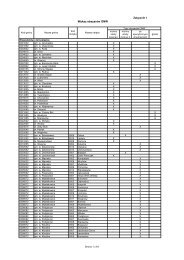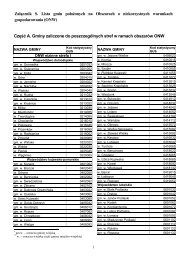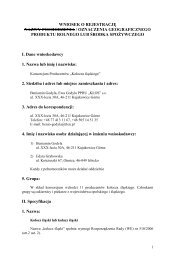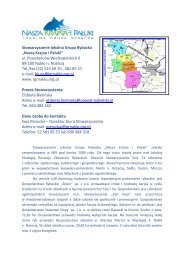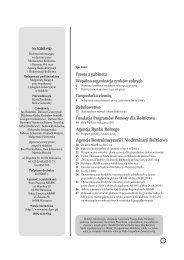agriculture and food economy in poland
agriculture and food economy in poland
agriculture and food economy in poland
You also want an ePaper? Increase the reach of your titles
YUMPU automatically turns print PDFs into web optimized ePapers that Google loves.
AGRICULTURE<br />
Figure 10. Structure of particular crops <strong>in</strong> 1990 <strong>and</strong> 2003 (%)<br />
Source: GUS<br />
Area sown<br />
1995 - 12 892<br />
2003 - 10 889<br />
Total cereals<br />
Pulses for gra<strong>in</strong><br />
Potatoes<br />
Sugar beets<br />
Oilseed crops (rapeseed, agrimony)<br />
Fodder crops<br />
Field vegetables<br />
Other<br />
11,8<br />
permanently <strong>in</strong>creas<strong>in</strong>g. Another important crop is potato, though its cultivation has<br />
been constantly reduced, fodder crops <strong>and</strong> legum<strong>in</strong>ous plants for gra<strong>in</strong>. The share<br />
of vegetables with<strong>in</strong> the crops structure has been stable.<br />
The areas sown to particular crops were adjusted to sales possibilities <strong>and</strong><br />
profitability of particular types of agricultural production. Generally, a supply<br />
surplus persisted on the market except for the years characterised by extremely<br />
disadvantageous weather conditions.<br />
Despite a high share of cereals <strong>in</strong> the area sown to crops, Pol<strong>and</strong> has been a net<br />
importer of the majority of cereals. Imports do not only cover high-gluten varieties<br />
of wheat, for the cultivation of which there are no appropriate agro-climatic<br />
conditions <strong>in</strong> Pol<strong>and</strong>, but also fodder gra<strong>in</strong>s (especially maize) <strong>and</strong> malt<strong>in</strong>g barley.<br />
In 2003 yields of major crops were lower <strong>in</strong> than <strong>in</strong> 2002. Yields <strong>in</strong> Pol<strong>and</strong> are<br />
approximately twice as low as those <strong>in</strong> the EU. Compared to certa<strong>in</strong> EU member<br />
states such as Greece <strong>and</strong> Spa<strong>in</strong>, cereals yields <strong>in</strong> Pol<strong>and</strong> are higher, however, they are<br />
significantly lower than <strong>in</strong> France, Germany, Denmark <strong>and</strong> the UK. Apart from worse<br />
agro-climatic conditions, the cause is a much lower usage of m<strong>in</strong>eral fertilisers (by ca<br />
30%) <strong>and</strong> plant protection products (several times lower) than on average <strong>in</strong> the EU.<br />
A favourable change <strong>in</strong> plant production is an <strong>in</strong>crease <strong>in</strong> production<br />
concentration, i.e. larger area under particular plants on big farms. An <strong>in</strong>crease <strong>in</strong><br />
average area sown to the majority of crops (e.g. dur<strong>in</strong>g the eight years between the<br />
Agricultural Censuses <strong>in</strong> 1996 <strong>and</strong> 2002 – from 4.16 ha to 5.16 ha for cereals, from 1.50<br />
ha to 2.64 ha for sugar beets, from 0.22 ha to 0.38 ha for vegetables) was accompanied<br />
by a rise <strong>in</strong> the number of farms grow<strong>in</strong>g cereals on the area of at least 10 ha (from 124<br />
800 to 157 900 farms), potatoes (from 884 to 1 389 farms), sugar beets (from 1 300<br />
1<br />
13<br />
3 4,7<br />
1,1<br />
4,2<br />
2,6<br />
7<br />
8,4<br />
2,2 3,9<br />
6,4 1,8 2,6<br />
1995<br />
2003<br />
66,5<br />
75






